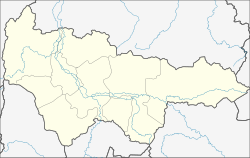Jugorsk
| city
Yugorsk
Югорск
|
||||||||||||||||||||||||||||||||||||||||||
|
||||||||||||||||||||||||||||||||||||||||||
|
||||||||||||||||||||||||||||||||||||||||||
| List of cities in Russia | ||||||||||||||||||||||||||||||||||||||||||
Yugorsk ( Russian Югорск ) is a city in Western Siberia , in the Khanty and Mansi Autonomous Okrug / Yugra ( Russia ) with 34,067 inhabitants (as of October 14, 2010).
geography
The city of Jugorsk is located in the west of the Khanty and Mansi Autonomous Okrug, between the Ob River and the Ural Mountains in the West Siberian lowlands . The climate is continental.
The town forms a separate urban district, the territory of the Rajons Sovetsky is enclosed.
Jugorsk lies on the railway line Ivdel - Priobje , opened in 1969 ; the name of the station is Geologicheskaya (Геологическая).
history
The place and a forestry enterprise came into being in 1962 when the railway line Ivdel - Priobje was built under the name Komsomolski (Комсомольский). As early as 1963, it received urban-type settlement status . In 1992 the settlement was renamed Jugorsk and received city rights.
The name is derived from the old name Jugra (Югра) or Jugorien (Югория, Jugorija), which in the 12th to 17th centuries denoted the areas between Pechora and the Northern Urals and the settlement areas of the Khanty and Mansi in western Siberia.
In 1996 the village of Mansiysky (Мансийский) and the settlement near the garrison of the Russian army Komsomolski-2 were incorporated.
Population development
| year | Residents |
|---|---|
| 1970 | 6,565 |
| 1979 | 12,540 |
| 1989 | 24,928 |
| 2002 | 30,285 |
| 2010 | 34,067 |
Note: census data
Education, culture and sights
Since 2001 there has been a city museum in Jugorsk about the history of the place and the most important company Tyumentransgas , as well as the culture of the Khanty and Mansi.
In 2002 a Russian Orthodox Church of St. Sergius of Radonezh was built.
In Jugorsk there are branches of several regional universities of applied sciences (business and law, forestry, electrical engineering).
economy
Several pipelines for the transport of natural gas from the West Siberian production areas to the European part of Russia run through Jugorsk . Therefore, the largest company in the city is to the consolidated Gazprom belonging Tjumentransgas (Тюментрансгаз).
The municipal enterprise Jugorskles (Югорсклес) operates in addition to its core business, forestry (with sawmills, furniture production), a brickworks and a sewing shop.
See also
Individual evidence
- ↑ a b Itogi Vserossijskoj perepisi naselenija 2010 goda. Tom 1. Čislennostʹ i razmeščenie naselenija (Results of the All-Russian Census 2010. Volume 1. Number and distribution of the population). Tables 5 , pp. 12-209; 11 , pp. 312–979 (download from the website of the Federal Service for State Statistics of the Russian Federation)
Web links
- City administration website (Russian)
- Jugorsk on mojgorod.ru (Russian)



